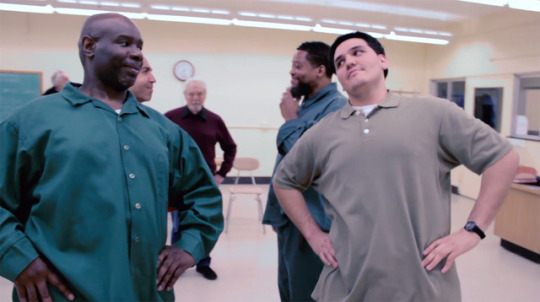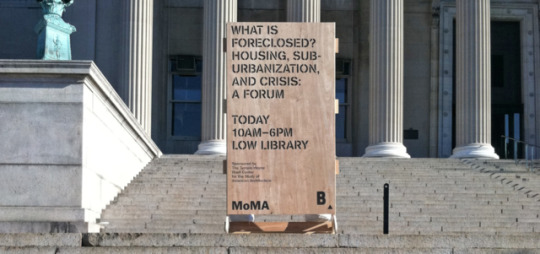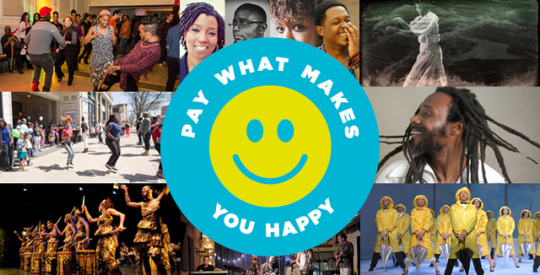Photo

Cornell Interactive Theatre Ensemble (CITE)
Diversity and inclusion training that facilitates dialogue.
WHAT CITE DOES
CITE programs create safety around highly charged workplace issues, facilitating honest dialogue, self-awareness and organizational learning on four levels: personal, interpersonal, group and institutional/community.
CITE has the unique ability to take concepts of diversity and inclusion and make them real and personal for participant groups. Interactive theatre and facilitated dialogue from multiple points of view create a climate for participants that builds inclusion, fosters collaboration and gives participants knowledge and tools to take back to their own work environments.
All CITE scenarios are multi-dimensional, revealing not only the dynamics of particular diversity issues, but also the dynamics of humaninteraction around the issues.
0 notes
Photo

Foreclosed was a collaboration between Temple Hoyne Buell Center, the School of Architecture at Columbia University, and NY’s Museum of Modern Art that created new tools around reimagining public housing, particularly in the economic and housing crises. The workshop and community engagement activities produced a pamphlet, screen play, website with comments from the workshop, and field guide to lead future conversations and engagements. Projects like this series open up a space for community, artists, and administrators to engage in dialogue that can further examine the issues around housing while also taking an active stance and creating content to be distributed.
0 notes
Photo

The Kelly Strayhorn Theater believes that we build better communities by supporting the people who engage the world with a passionate creativity, generosity, and a deep vision for justice, connection and healing.
We’ve seen that communities thrive best when the creative leaders are connected to the community as more than a series of buildings, but rather with a network of people, spaces, memories and possibilities.
Penn Avenue Creative works with emerging artists, social change leaders and entrepreneurs to ignite transformative thought, build systems of connectivity and catalyze networks of cultural sustainability along the Penn Avenue Corridor.
Penn Avenue Creative offers emerging creative leaders network development, mentorship, sessions with field experts, and a project development stipend. How do you build better communities for all? You do it by supporting the people who work, dream and live in ways that answer that question, everyday. Penn Avenue Creative is a demonstration of Kelly Strayhorn Theater’s continued commitment to being, growing and developing that support in the East End.
0 notes
Video
vimeo
William Estrada was born to immigrant parents and grew up assembling memories in California, Mexico, and Chicago. His teaching and art making practice focuses on engaging the complex experiences within marginalized communities and contested spaces. He documents and analyzes public/private learning spaces to transform, question, and make connections to established and organic systems through discussion, creation, and promotion of counter narratives.
William's work is a discourse of existing images, text, and politics that appoints the audience to critically re-examine the meanings of their surroundings. As a teacher, artist, cultural worker, and urban anthropologist he reports, records, reveals, and imparts experiences you find in academic books, school halls, teacher lounges, kitchen tables, barrios, college campuses, and in the conversations of close friends.
His current research is focused on developing community based and culturally relevant programs that question power structures of race, economy, and cultural access.
0 notes
Photo

Through the activation of public spaces around the world, artist Candy Chang creates work that examines the dynamics between society and the psyche, the threshold between isolation and community, and the role of the commons in contemporary wellbeing. She is interested in the relationship between public space and mental health, the tension between individual liberty and social cohesion, and a city that exposes and fosters the complexity of the individual and collective psyche.
0 notes
Photo

Evan Bissell facilitates participatory art and research projects that support equitable systems and liberatory processes. Projects take varied forms: an interactive online history of freedom and confinement in the United States told through 50 miniature paintings (knottedline.com), poster installations and community surveys about broken windows policing in the Bronx, and collaborative, life-size portrait paintings created with incarcerated fathers and children of incarcerated parents. Evan has exhibited at CUNY Graduate Center, on Alcatraz Island, at Yerba Buena Center for the Arts, Intersection for the Arts, and SOMArts, and facilitated projects in schools (K-12) and community settings throughout the country. He has taught in public school grades 6-12 and courses on art and social change at UC Berkeley. Evan was an activist-in-residence at the Arcus Center for Social Justice Leadership at Kalamazoo College (2015), the first artist-in-residence at the American Cultures Engaged Scholar Program at UC Berkeley (2013), and was awarded a Headlands artist-in-residence (2013) and the Roselyn Lindheim fellowship (2015). He currently serves on the Advisory Board for the Allied Media Conference in Detroit. He compiled the first Health in All Policies report for the City of Richmond (2015) and worked as an artist/researcher with the Public Science Project at CUNY Graduate Center (2014-15). He received a master’s in Public Health and City Planning from UC Berkeley in May 2016 and is a firm believer in reading groups.
0 notes
Photo

Young Nation's mission is to promote holistic development of youth in urban settings through building relationships, community education, and passion-driven projects.
Young Nation believes in the vision that quality, culturally and developmentally competent programs for youth can develop, grow, and flourish in our urban communities with minimal and efficient investment of limited resources and liberal investment of value created from participation in social networks.
This can be done by tapping into youths' talents and interests, encouraging youth input, channeling the resulting passion, showing youth and adults how to harness their social capital, promoting partnerships in the community, building mentoring relationships, and sharing community resources rather than relying solely on limited resources for programming.
TAP (The Alley Project) is an initiative of Young Nation. The gallery includes a garage that contains a studio and gallery space for youth and the community, two lots that provide a common art space for neighbors and artists, bike racks for youth traveling on two wheels, and a walking gallery along an alley that spans one city block with high-quality, multi-color murals with signage to honor and explain the history of the pieces and the alley on garages and other surfaces. In these spaces youth and community members can create, show, and/or see street art in a way that is legal, safe, and supports learning and relationships!!
0 notes
Photo

Yollocalli Arts Reach is the award-winning youth initiative of the National Museum of Mexican Art, we offer FREE arts and culture programming to teens and young adults.
Located in the heart of Chicago’s Little Village neighborhood, we serve as an open community center with studio spaces, computer lab, radio production studio, a large art library, and a creative, supportive staff who are always around to help, encourage, and inspire. We aim to strengthen the students’ creative and cultural capital by engaging them with their own cultural discourses through art making.
0 notes
Video
vimeo
Warm Cookies of the Revolution : The world’s first Civic Health Club!
“Uh, so what’s a Civic Health Club” you ask?
Well, you go to a gym to exercise your physical health, a religious institution to exercise your spiritual health, and a therapist to exercise your mental health. Warm Cookies of the Revolution is where you go to exercise your Civic Health.
“Got it….But what is Civic Health?”
Another great question. You’re sharp. And classy. And really good looking…..
Civic Health is a measurement of how well we participate in our community as citizens. Are we engaged in the decision making processes? When it comes to our environment, our education, our government, our work/life balance, our health, our systems of justice, etc, do we have power? Do we know how to affect change? Are our needs and hopes being met?
“That sounds boring…and hard.”
That’s what we’re trying to avoid. We are about fun. We know that people work hard all day and are raising families and often the last thing they want to do is go hear a boring lecture on the city budget or be told that the world is falling apart no matter what we do.
So, we try to answer the questions “What do we want?” and “How do we get there?” by hosting events that are creative and fun.
Want to talk about how government should be run? Fine, but we’re going to build a LEGO city together while it happens! You’re telling me I have to write my elected officials?…okay, but there better be warm cookies and some milk there…and possibly dance breaks.
The truth is that those of us who enjoy watching football on Sundays, and those of us who like to knit, or bake, or tell stupid jokes, or wish we could walk down the fashion runways of Paris, or like to build robots….we all have the capacity to understand and take part in the decisions that affect our lives. We know that the Revolution won’t be televised and that we have to take part, but the Revolution also shouldn’t be boring and we should be able to dismantle the aspects of our community that aren’t working while creating beautiful and vibrant and fun, new systems.
0 notes
Photo

Every year, more than 200 people are killed while trying to move throughout Los Angeles. Nearly half the people killed on the streets are those who were walking or bicycling, and an alarming number of them are children and older adults. In fact, traffic collisions are a leading cause of death for children in Los Angeles.
Vision Zero Los Angeles is Los Angeles’ commitment to eliminate all traffic deaths by 2025. As directed by Mayor Garcetti, this citywide effort brings together transportation engineers, police officers, advocates, and policymakers to work together towards creating safer streets. The focus will be protecting our most vulnerable road users, including children, older adults, and people walking and bicycling.
The program also includes a interactive map that shares the stories of those who have lost their lives and is a place where they can be memorialized. There is also a Creative Catalyst Artist in Residence program that uploads observations about the City, transportation and the pedestrian experience including a podcast series.
0 notes
Video
vimeo
The 303 ArtWay is an exciting new catalyst for Denver. It is a proposed art-themed urban trail connecting paved walkways and bike paths through the Park Hill Neighborhood with a larger vision to expand through Denver. The trail will highlight the visionaries and artists, leaders and community activists who have brought so much life to this unique and diverse neighborhood.
The “303” will provide:
o Improved sidewalks and bike infrastructure, creating safer routes through the area, and in the process reducing car traffic while encouraging a healthier, more active lifestyle.
o It will improve “first- and last-mile connections” to the new transit station, allowing residents better access to the entire metro Denver region via the region’s expanding light and commuter rail network.
o A reason for more people to get outside and walk, bike, or wheelchair roll. And more people outside in their communities means more “eyes on the street” making neighborhoods safer by reducing crime and allowing residents to feel better about where they live.
o Because this area of the city has insufficient public infrastructure, and also has residents who suffer from some of the highest rates of obesity, heart disease, and other health maladies in the metro area, this future urban trail—and all the attributes it can provide--could make a monumental difference in the quality of life for many NE Denver residents.
o BUT, the trail will be more than just a new way to get around NE Denver—it also will be used to highlight Denver art and artists, as well as local history, heritage, and culture.
o In a larger sense, the creation of the 303 is a chance to show the region and the nation how improved walking and biking connectivity, along with local art and heritage, can strengthen the bonds of community, contribute to neighborhood “placemaking,” and make for a fun and healthy viable alternative to people using their cars to get around their own neighborhoods.
0 notes
Photo

Annie Koh is a writer for Progressive City and her own blog City Publics. Recently she was a part of the Decolonizing Cities Symposium at the University of Hawai’i. The symposium focused on “...possibilities for indigenous urbanism and decolonizing urban planning by creating a space to talk about something we are not sure how to define or do but that we know is essential for justice and our collective futures. What does aloha ‘aina look like in Honolulu? How does native knowledge provide solutions to perennial urban dilemmas? What are the key touchstones in the effort to decolonize cities and how can we decolonize urban development and municipal change?”
0 notes
Photo

Sweet Water Foundation practices Regenerative Placemaking, a creative and regenerative social justice method, that creates safe and inspiring spaces and curates healthy, intergenerational communities that transform the ecology of once-blighted neighborhoods.
Sweet Water Foundation utilizes a blend of urban agriculture, art and education to transform vacant spaces and abandoned buildings into economically and ecologically productive and sustainable community assets that produce engaged youth, skilled workers, art, locally-grown food, and affordable housing.
0 notes
Photo

Springboard for the Arts believes artists and communities thrive when they work together. There goal is always to create projects that are adaptable to the the needs of individual communities; and to catalyze relationships and mechanisms that bring artists and communities together, and have lasting impact. In the Irrigate Project, Springboard for the Arts partnered with the City of St. Paul to contract with artists to activate spaces while development of a rail was being built throughout the community. Artists engaged community members and local businesses to stabilize communities through this time of change. Performers came to businesses that were in construction zones to promote activity, vacant lots were turned into pop-up art shows, and residents explored their neighborhoods in new ways.
0 notes
Photo

Mallory Nezam entrepreneurial social practice civic artist, cultural producer, writer, communications strategist and urban strategist passionate about engagement that dissolves barriers. Her work reimagines ways in which we utilize urban spaces and disrupts the psychogeography of segregation and silence. Her practice integrates intervention, performance, play, movement, and mindfulness to activate the public spaces and people of cities. She believes that collectively performing creative expressions in public builds a bond between citizens and an ownership of place. Mallory serves as the Founding Director of STL Improv Anywhere, a guerrilla performance collective disrupting public spaces with joy and mischief. She is also the Co-Creator of Building as Body, The Poetree Project, and #ChalkedUnarmed. My work has been supported by the Regional Arts Commission, Pulitzer Arts Foundation, Gephardt Institute for Civic and Community Engagement, Marfa Dialogues, the City of St. Louis, and more. She is also a writer, and has been published in Hyperallergic, Temporary Art Review, Public Art Review, Art Animal Magazine, Riverfront Times, The Mantle, FEAST Magazine, Alive Magazine and more. She also serves as a member of the national Placemaking Leadership Council for Projects for Public Spaces, and formerly served on the Next City Advisory Committee. Mallory currently works with Transportation for America as well.
0 notes
Photo

Nina Simon has been described as a “museum visionary” by Smithsonian Magazine for her audience-centered approach to design. She is the Executive Director of the Santa Cruz Museum of Art & History, and has consulted with hundreds of international museums, libraries, parks, historic sites, art and cultural centers on issues of relevance, community engagement, and participatory design. Nina is the author of the best-selling book The Participatory Museum and the popular Museum 2.0 blog. Her work has been shared in the Wall Street Journal, New York Times, NPR, and TEDx.
0 notes
Photo

Healthy Eating Active Communities (HEAC) and Public Matters in South L.A. have been working with high school students and local convenience stores in a program called Market Makeovers to document the need, stimulate the demand, and provide healthy food options like fresh produce in the ‘food deserts’ of L.A. Local students create awareness around food issues by producing videos and revamp corner stores then promote healthy foods and get fresh foods stocked. The organizations also help provide cooking classes and healthy recipes for community members. The project has made-over five markets to date.
0 notes